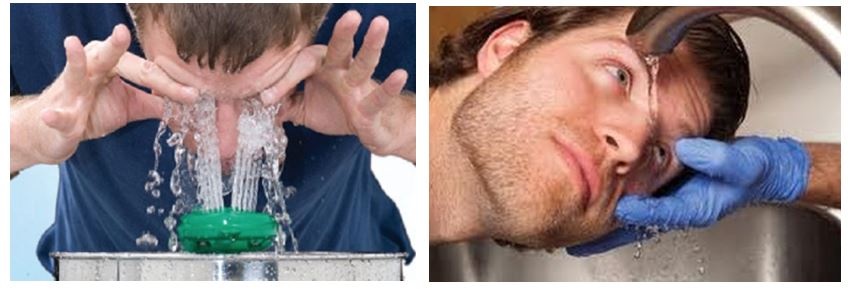Bleach in my eye!
First Aid for Chemical Burns
Bleach, oven cleaner, ammonia, detergents, pool cleaner and vinegar: we are all familiar with these useful chemicals for cleaning and use them often. However if any of these chemicals spatter into your eye it is a true ocular emergency that can possibly lead to blindness or visual impairment and requires treatment IMMEDIATELY.

About two-thirds of chemical eye injuries occur in industries where dangerous chemicals are used, and the remainder occur at home mostly from cleaning products.
Here is a list of chemicals that are harmful to your eyes:
- Alkali
- Bleach
- Lye
- Cements
- Plasters
- Airbag powder
- Ammonia
- Solvents
- Potassium hydroxide
- Sodium hydroxide
- Magnesium
- Lime
- Fertilizer
- Mace, pepper spray
- Household detergents
- Battery acid (automobile battery)
- Pool cleaner
- Vinegar
- Glass polish (hydrofluoric acid)
Alkali burns are the most dangerous and harmful to the ocular surface as alkalis penetrate the cornea (the clear window in front of the eye) more deeply and rapidly than acids and will cause more severe injuries.
Symptoms of chemical burns include pain, redness, tearing, blurred vision, difficulty with keeping the eyes open, irritation and swelling of the lids.
The first and most important treatment for chemical burns is to irrigate and wash the injured eye copiously with water or saline for at least 20-30 minutes. The longer the chemical remains in the eye the more devastating harm it causes. Also it is very important to open the eyes as wide as possible to effectively wash off the chemical. It is often useful to hold the lids with both hands to keep the eye open.
It would be ideal if irrigation can be performed with an irrigating solution such as Eye Stream or saline, but tap water is also appropriate.

When seeking medical help or calling an ambulance, it is essential to inform the health care practitioner what chemical was splashed in the eye and if in an industrial setting to provide a MSDS: Material Safety Data Sheet. Irrigation must be continued until the ambulance arrives or you arrive at a hospital emergency department.
The types and duration of treatment depend on severity of the burn, which is graded from Grade 1 to Grade 4.
Grade 1: Clear cornea, only epithelial damage and no limbal ischemia
Grade 2: Hazy cornea, iris details visible, less than 1/3 of limbal ischemia
Grade 3: total loss of corneal epithelium, stromal haze, 1/3-1/2 limbal ischemia
Grade 4: Opaque cornea, more than ½ limbal ischemia
Overall chemicals must be used and treated with great care and protective goggles used. If chemical spatters into the eye remember two things: IRRIGATE COPIOUSLY and SEEK MEDICAL HELP IMMEDIATELY.












